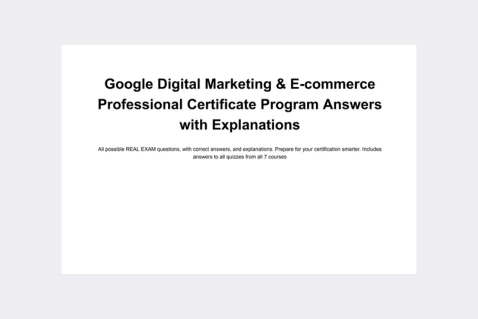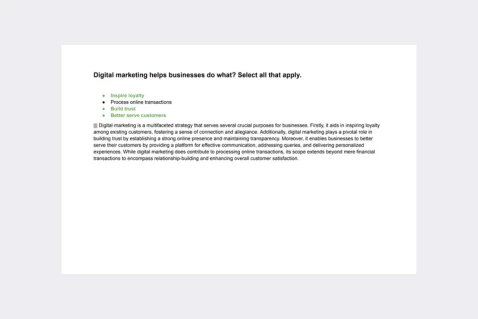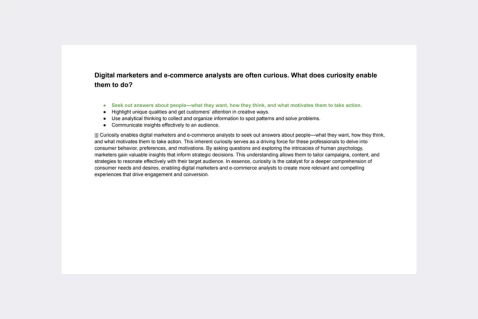A marketer is creating a data story and picks their data points and insights. What is the next step in creating a data story?
Create data visualizations
Understand which questions to answer
Build a narrative that conveys the insights effectively
Select which numbers to highlight
Certification program: 👉 Google Digital Marketing & E-commerce Professional Certificate (Coursera)
Explanation: Build a narrative that conveys the insights effectively is the next step in creating a data story after selecting data points and insights. Once the relevant data points are identified, the next crucial step is to construct a narrative around them. This involves organizing the insights into a cohesive and compelling story that addresses what the data means, why it matters, and what actions can be taken. Building a narrative ensures that the data is presented in a context that stakeholders can understand, making it more impactful and actionable. Unlike other options such as creating visualizations, understanding questions, or selecting highlighted numbers, building a narrative is the logical progression in transforming raw data into a meaningful and persuasive story.
Passing exams is not a workout. Multiple attempts won’t make you stronger.



- All possible certificate program questions
- Real certification exam questions
- Detailed answer explanations.
- Over 1700 questions, 7 courses, 30 quizzes
- Free lifetime updates.
Crafting Compelling Data Stories: The Next Step After Choosing Data Points and Insights
In the realm of data-driven marketing, crafting compelling data stories is essential for effectively communicating insights, driving decision-making, and influencing outcomes. Once a marketer has carefully chosen their data points and uncovered meaningful insights, the next step in creating a data story is:
Analyzing and Contextualizing the Data
While selecting data points and insights is a critical first step, it’s equally important to analyze and contextualize the data to provide a deeper understanding of the narrative. Here’s why this step is crucial and some practical insights for executing it effectively:
1. Analyzing Data Trends and Patterns
After choosing data points, marketers need to analyze trends, patterns, and correlations within the data to uncover hidden insights and opportunities. This involves examining historical data, identifying anomalies, and understanding the underlying drivers behind observed trends. By analyzing the data comprehensively, marketers can provide valuable context that enriches the narrative and enhances understanding.
2. Providing Contextual Insights
Context is key to making data meaningful and actionable. Marketers must provide context by explaining the significance of the data points, highlighting implications for the business, and connecting the insights to broader industry trends or market dynamics. By contextualizing the data, marketers can help stakeholders make informed decisions and take appropriate actions based on the insights presented.
3. Visualizing Data Effectively
Visualizing data through charts, graphs, and infographics is essential for making complex information more digestible and engaging. Marketers should choose visualizations that best represent the data and reinforce the key messages of the story. By presenting data visually, marketers can enhance comprehension and retention, making it easier for stakeholders to grasp the insights and implications.
4. Crafting a Compelling Narrative
Finally, marketers need to craft a compelling narrative that weaves together the data points, insights, and contextual information into a cohesive story. This involves structuring the data story in a logical sequence, emphasizing key points, and guiding the audience through a narrative arc that builds to a meaningful conclusion or call to action. By framing the data within a compelling narrative, marketers can captivate their audience and inspire action.
Practical Insights for Analyzing and Contextualizing Data
-
Dig Deeper: Look beyond surface-level insights and dig deeper into the data to uncover hidden patterns, correlations, and anomalies that provide valuable context.
-
Connect the Dots: Draw connections between data points, business objectives, and industry trends to provide a holistic view of the story and its implications.
-
Use Clear Language: Communicate insights using clear and concise language that is accessible to stakeholders with varying levels of data literacy.
-
Engage Stakeholders: Involve key stakeholders in the data analysis process to gain additional perspectives and ensure buy-in for the insights presented.
In conclusion, analyzing and contextualizing data is a critical step in creating compelling data stories that inform, persuade, and inspire action. By diving deep into the data, providing meaningful context, visualizing insights effectively, and crafting a compelling narrative, marketers can unlock the full potential of their data and drive impactful outcomes for their business.
Now, armed with these insights, how will you elevate your data storytelling efforts to create more impactful narratives that drive results for your business?
Discover our best-value guides
- Special Bundle Offer Google_Ads_Roll
- Special Bundle Offer HubSpot_Exams_Roll
- Special Offer Unchained_Guru_Roll
- Special Bundle Offer Amazon_Roll
- Special Bundle Offer Google_Analytics_Roll
- Special Bundle Offer Google_SkillShop_Roll
- Special Bundle Offer Marketing_Platforms_Roll
- Special Bundle Offer Microsoft_Advertising_Roll
- Special Bundle Offer YouTube_Roll
- Special Bundle Offer Google_Android_Roll
- Ultimate PMP certification preperation guide
- Google Cloud Professional Architect Certification Exam Answers - Ultimate Guide
- Special Bundle Offer SEMrush_Roll